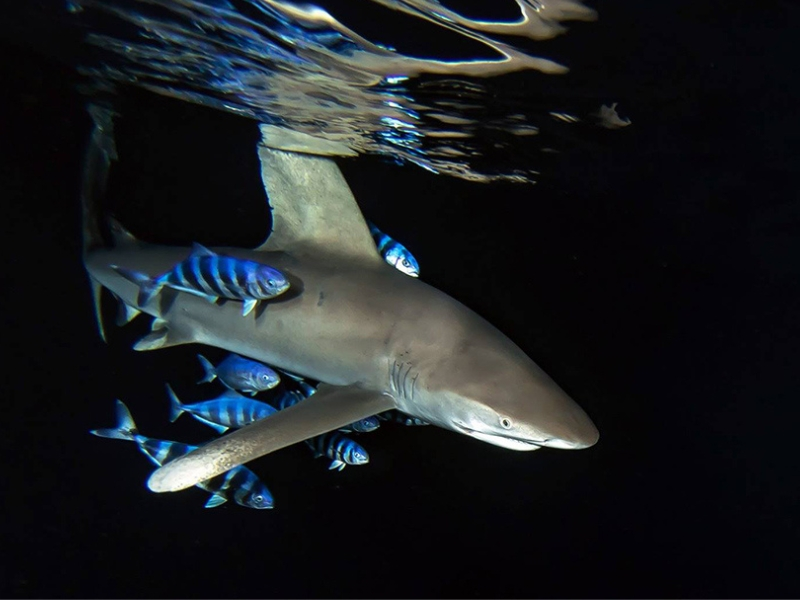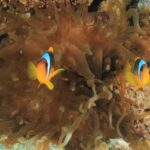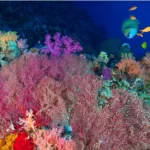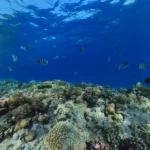Egypt Liveaboard provides you with the most comprehensive information on 22 different species of sharks found in the Red Sea. The Red Sea is a top destination for shark diving, with 22 different species of sharks found in its waters. If you’re an advanced diver looking to catch a glimpse of larger sea creatures in their natural habitat, the Red Sea offers an unforgettable experience. Some of the most famous dive sites for shark encounters in the Red Sea include Brothers Islands, Daedalus Reef, Elphinstone Reef, and St. John’s. At Egypt-Liveaboard, our specialized team values the importance of diving safely with sharks to guarantee an adventure and safe dive. Experience the thrill of diving with these majestic creatures at the Red Sea, a must-do destination for all divers.
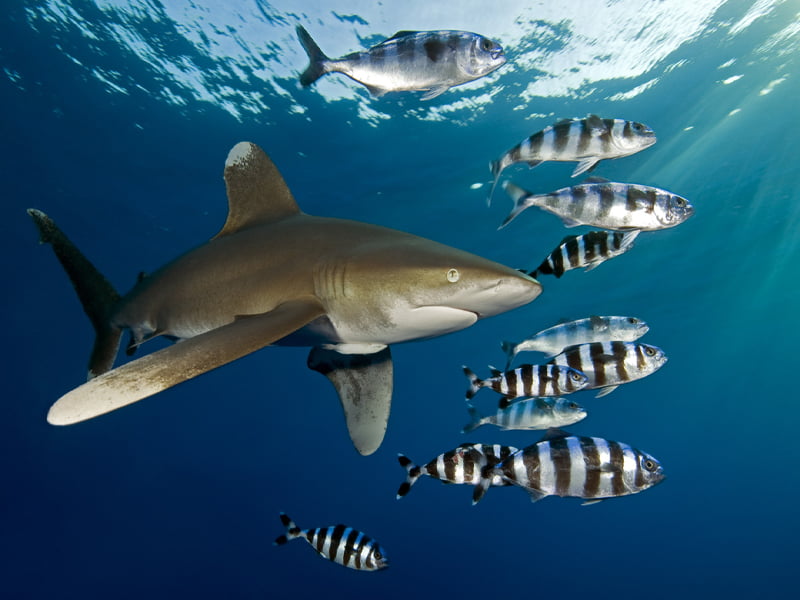
Oceanic Whitetip Shark
Length: 3 to 4 Meter | 10 to 13 Feet
Weight: 56 to 170 Kg
The oceanic whitetip shark is a large and powerful shark species that can be found in the waters of the Red Sea, including the southern Red Sea near the Brothers Island, Elphinstone, and Daedalus Reef. They are known for their distinctive long, pointed pectoral fins and white tips on their dorsal and caudal fins.
Oceanic whitetip sharks are apex predators and are known for their aggressive hunting behavior. They are opportunistic feeders and will eat a variety of prey, including fish, squid, and even sea turtles. Despite their fearsome reputation, oceanic whitetip sharks are not typically a threat to humans and will generally avoid contact with people.
The population of oceanic whitetip sharks has declined in recent years due to overfishing and the demand for their fins. As a result, they are now considered a vulnerable species by the International Union for Conservation of Nature (IUCN).
To protect these sharks and their habitat, it is important to promote responsible fishing practices and to reduce the demand for shark fins. Additionally, divers and snorkelers should be cautious when swimming in areas where oceanic whitetip sharks are known to inhabit, and should always give these sharks plenty of space and respect their territory.
The oceanic whitetip shark is a fascinating and important species that plays a crucial role in maintaining the health of the ocean’s ecosystem. By taking steps to protect them and their habitat, we can ensure the survival of these magnificent creatures for generations to come.
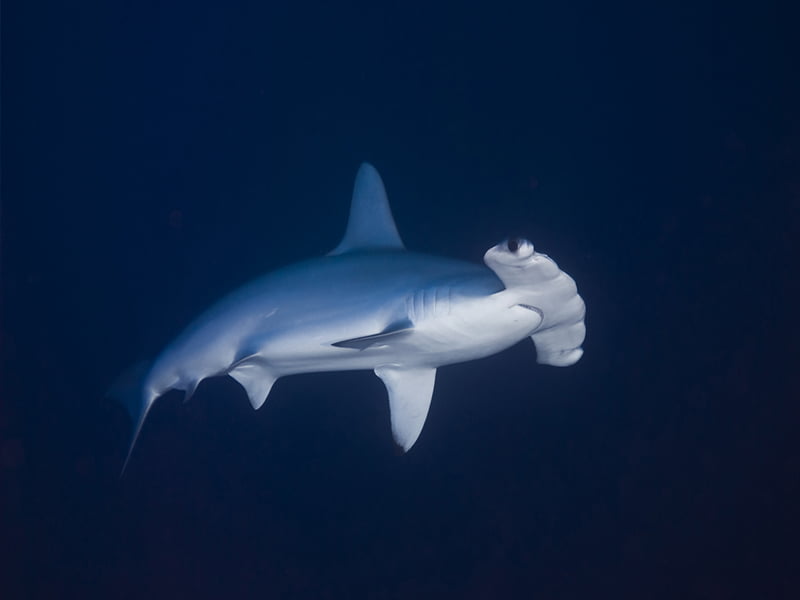
HummerHead Shark
Length: 4 to 6 Meter | 13 to 20 Feet
Weight: 84 to 580 Kg
Hammerhead sharks are a unique and fascinating species that can be found in the Red Sea, as well as other tropical and subtropical waters around the world. They are named for their distinctive head shape, which is flattened and extended into a “hammer” shape that provides enhanced sensory abilities and maneuverability.
There are several species of hammerhead sharks, each with their own distinct characteristics. Some of the most commonly encountered species in the Red Sea include the smooth hammerhead, great hammerhead, and scalloped hammerhead.
Hammerhead sharks are generally large, ranging in size from 3 to 20 feet in length, depending on the species. They are powerful hunters that feed on a variety of prey, including fish, squid, and crustaceans.
Despite their fearsome appearance, hammerhead sharks are typically not a threat to humans. They are shy and elusive, and will generally avoid contact with people. However, it is still important to treat these sharks with respect and caution when swimming or diving in their habitat.
Hammerhead sharks play an important role in the ocean’s ecosystem, helping to maintain a healthy balance of marine life. They are also popular among divers and snorkelers, who enjoy watching them swim gracefully through the water.
As with all wildlife, it is important to protect the habitat of hammerhead sharks and other marine creatures for future generations to enjoy. By practicing responsible tourism and avoiding behaviors that may harm these animals, we can ensure their survival and the preservation of our planet’s precious underwater ecosystems.
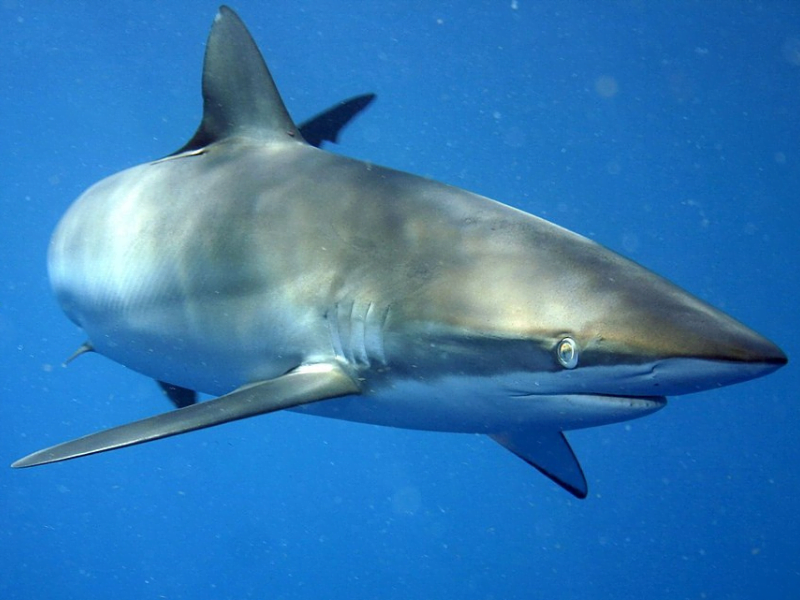
Silky Shark
Length: 2 to 3.5 Meter | 6.5 to 11.4 Feet
Weight: 178 to 346 Kg
Silky Shark is a slender and agile shark with a long and pointed snout. It is named for its smooth and silky skin texture. Silky Sharks are a deep blue-grey color on their backs with a lighter underbelly. They are often found in open ocean environments, where they are known to travel long distances. They are known to be social animals and can often be found in large schools. Silky Sharks are opportunistic feeders and will eat a variety of prey, including small fish, squid, and crustaceans. While Silky Sharks are not considered a direct threat to humans, they can be curious and may approach divers if they feel threatened or if they mistake them for prey. It is important to give these sharks plenty of space and respect their territory.
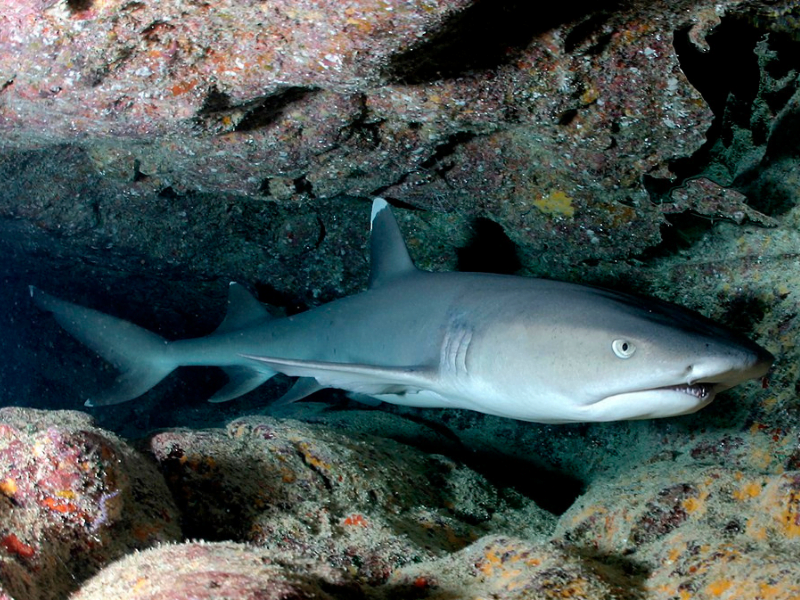
Whitetip Reef Shark
Length: 1.5 to 2 Meter | 5 to 6.5 Feet
Weight: 10 to 18.3 Kg
Whitetip reef sharks are typically between 3 to 6 feet in length and are light brown or gray in color with a white underbelly. They are nocturnal hunters, feeding on small fish, crustaceans, and cephalopods in shallow reef environments.
Despite their fearsome reputation, whitetip reef sharks are generally not considered a threat to humans. They are shy and elusive, often retreating to crevices and caves during the day to rest. However, it is still important to treat these sharks with respect and caution when swimming or diving in their habitat.
Whitetip reef sharks play an important role in the ocean’s ecosystem, helping to maintain a healthy balance of marine life. They are also popular among divers and snorkelers, who enjoy watching them glide gracefully through the water.
As with all wildlife, it is important to protect the habitat of whitetip reef sharks and other marine creatures for future generations to enjoy. By practicing responsible tourism and avoiding behaviors that may harm these animals, we can ensure their survival and the preservation of our planet’s precious underwater ecosystems.
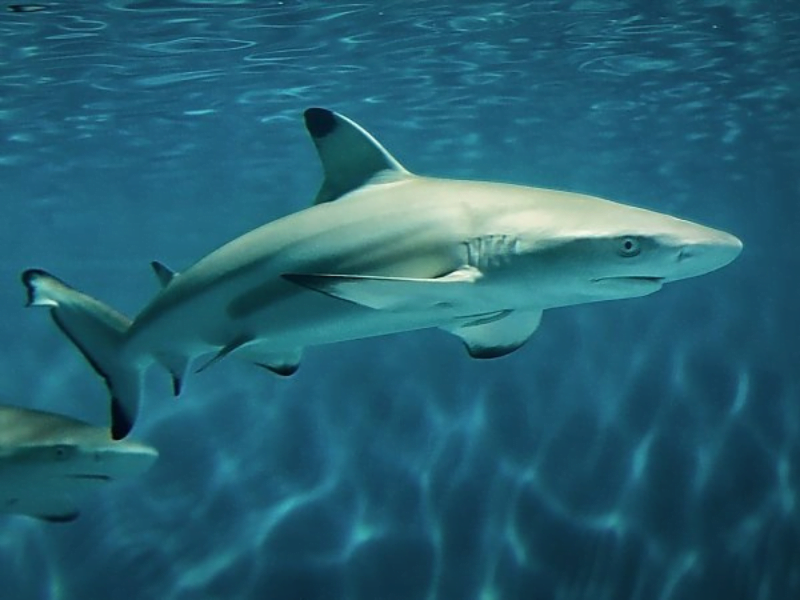
Blacktip Shark
Length: 1.5 to 2.5 Meter | 5 to 8 Feet
Weight: 68 to 123 Kg
Blacktip sharks are a common species found in the Red Sea, known for their black-tipped fins and sleek, streamlined bodies. They can grow up to 6 feet in length and are typically gray or brown in color with a white underbelly.
Blacktip sharks are known for their speed and agility, making them skilled hunters of small fish, crustaceans, and cephalopods. They are often found in shallow coastal waters, where they can be seen swimming near reefs and in estuaries.
Like many shark species, blacktip sharks are crucial to the ocean’s ecosystem, as they help maintain a healthy balance of marine life. They are also important to local fishing communities, providing a valuable source of food and income.
While blacktip sharks are generally not considered a threat to humans, it is important to treat them with respect and caution. In some cases, they have been known to approach swimmers or divers out of curiosity. It is best to keep a safe distance from these sharks and to avoid behaviors that may provoke them.
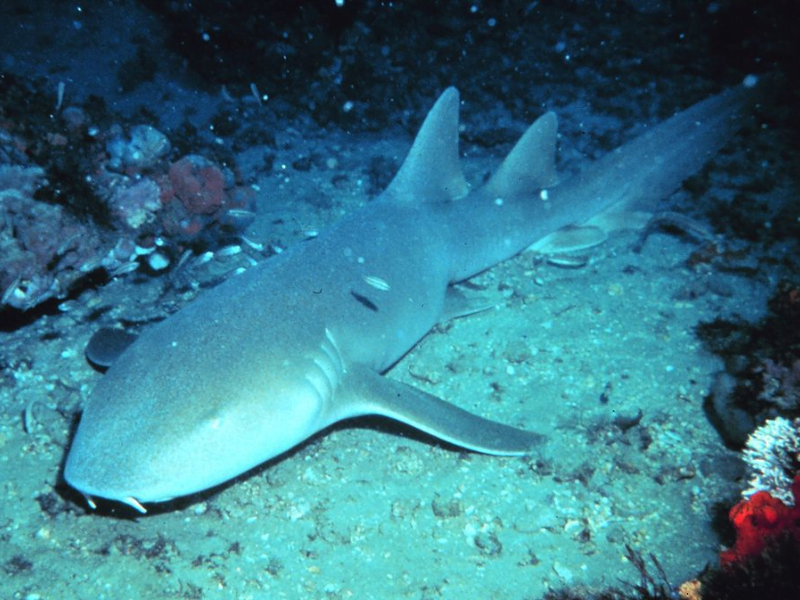
Tawny Nurse Shark
Length: 2.5 to 3 Meter | 8 to 10 Feet
Weight: 75 to 120 Kg
Tawny Nurse Shark is a species of carpet shark that has a distinctive appearance. They are typically light brown or gray with darker spots and a mottled pattern on their skin. They have a broad, flattened head with two small, widely spaced eyes and a wide mouth with fleshy barbels on their nostrils. They are typically found on sandy or rocky bottoms in shallow waters, but can also be found in deeper waters up to 100 meters. Tawny Nurse Sharks are nocturnal and spend their days hiding in caves or under ledges, coming out at night to hunt for crustaceans, mollusks, and small fish. They are not considered dangerous to humans and will generally swim away if approached.

Silvertip shark
Length: 2 to 3 Meter | 6.5 to 10 Feet
Weight: 92 to 162.2 Kg
More slender than Oceanic Whitetip and whilst it also has a white tip to its tail and dorsal fin, its dorsal fin is much more triangular. Its snout is more rounded. Much rarer to find as it is quite shy, but we have found them off the Brothers Islands and deep down off Elphinstone.
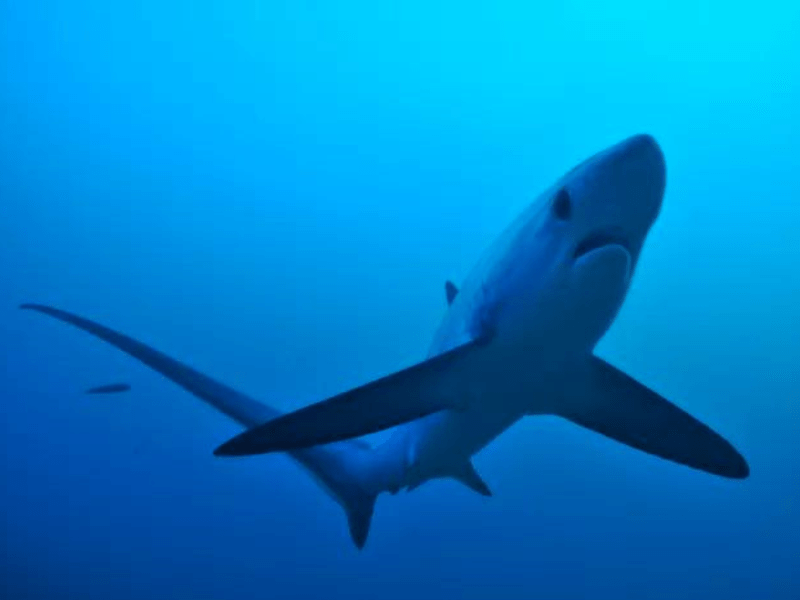
Thresher Shark
Length: 2.5 to 6 Meter | 8 to 20 Feet
Weight: 160 to 759 Kg
Dark blue/gery above and has a white underside. Has a very obvious, elongated upper lobe to its tail and large dorsal fins. I have only ever found this shark at one site and that is off the deep plateau of the southern tip of little Brother Island.
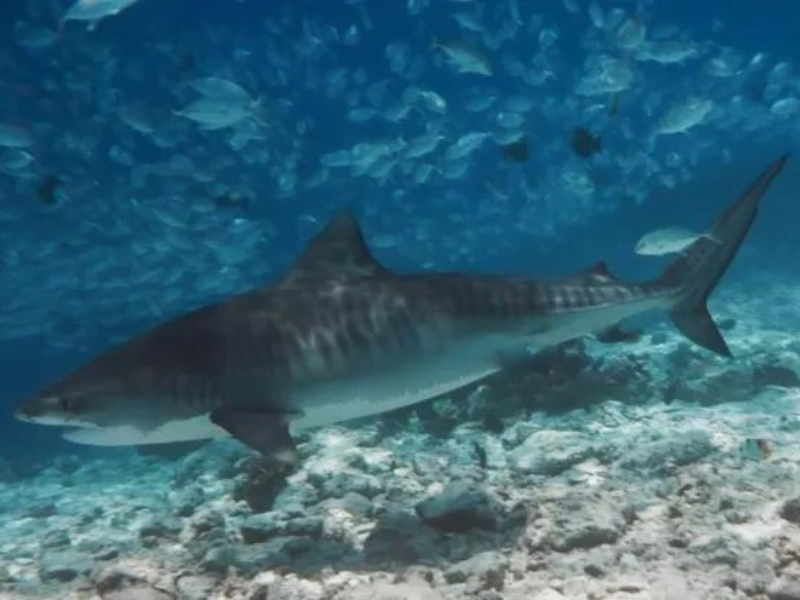
Tiger Shark
Length: 3 to 5 Meter | 10 to 17 Feet
Weight: 175 to 635 Kg
One of the most notorious shark species, tiger sharks can be found in the Red Sea, though they are less commonly seen by divers than some other reef associated species. Found globally in tropical and subtropical waters, in the Red Sea, tiger sharks are most often sighted around Tiran Reefs, Strait of Gubal, Safaga, Rocky Island, St.John Reefs and Elphinstone dive sites.
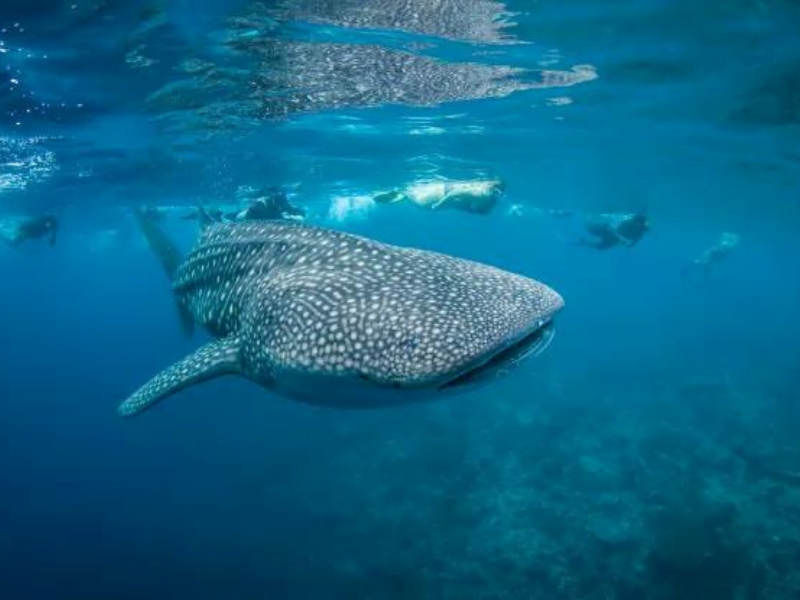
Whale Shark
Length: 5.5 to 12 Meter | 18 to 40 Feet
Weight: 800 to 19,500 Kg
One of the most obvious sharks of all with its huge, blunt head and ribbed body covered in white and grey spots. Sighted at Tiran Island, Ras Nasrani and Ras Zatar. The Largest fish in our seas and circumtropical, feeding on plankton and tiny fish whcih it follows during the large tidal movements of plankton. Almost always accompanied by pilotfish, cobias and numerous remoras.
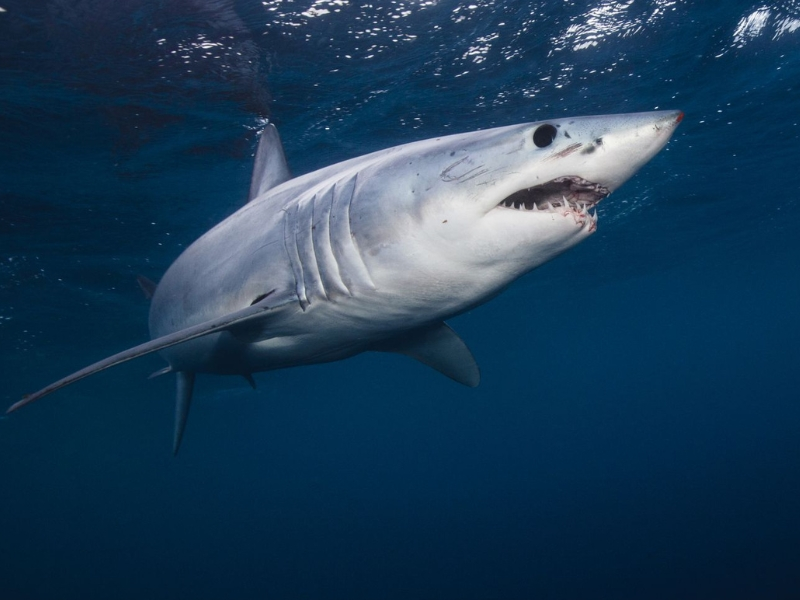
LONGFIN MAKO SHARK
Length: Up to 3 meters | Up to 10 feet
Weight: Up to 800 kg
Longfin Mako Shark, also known as Isurus paucus, is a species of shark found in the Red Sea and other warm waters around the world. They have a streamlined body with a long, pointed snout and large, dark eyes. Longfin Mako Sharks are typically blue or gray in color with a white belly. They are known for their speed and agility, and are considered one of the fastest swimming sharks in the ocean. Longfin Mako Sharks feed on a variety of prey including fish, squid, and other sharks. They are considered an important species for commercial and recreational fishing, but are also protected in some areas to prevent overfishing. Due to their size and speed, Longfin Mako Sharks are not typically encountered by divers.
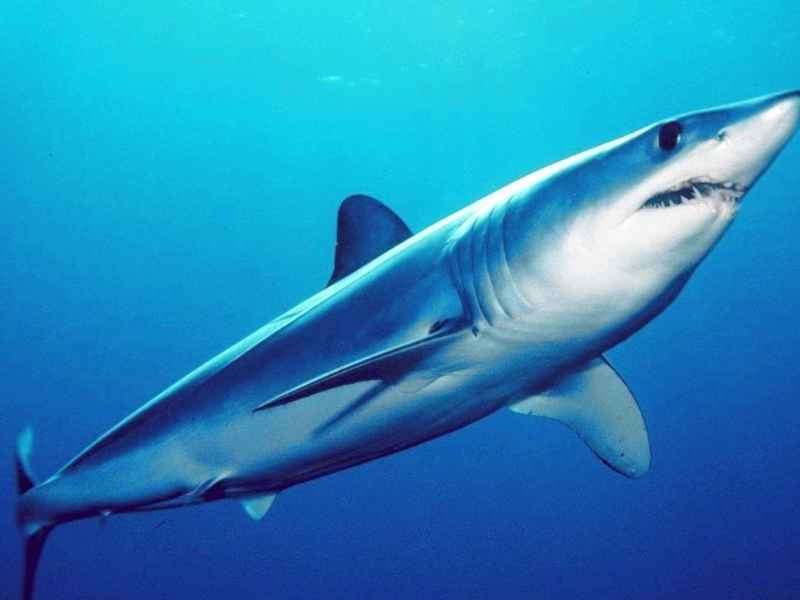
SHORTFIN MAKO SHARK
Length: Up to 3.8 meters | Up to 12.5 feet
Weight: Up to 570 kg
Shortfin Mako Shark is a fast-swimming and highly migratory shark found in open ocean environments around the world, including the Red Sea. They have a pointed snout, long slender body, and powerful tail that allows them to swim at high speeds. They are typically dark blue or gray on their dorsal side and lighter on their ventral side. Shortfin Mako Sharks are apex predators, feeding on a variety of prey including fish, squid, and other sharks. They are known for their aggressive behavior and can be a danger to humans, especially if provoked or cornered. Divers should exercise caution when diving in areas where Shortfin Mako Sharks are present.
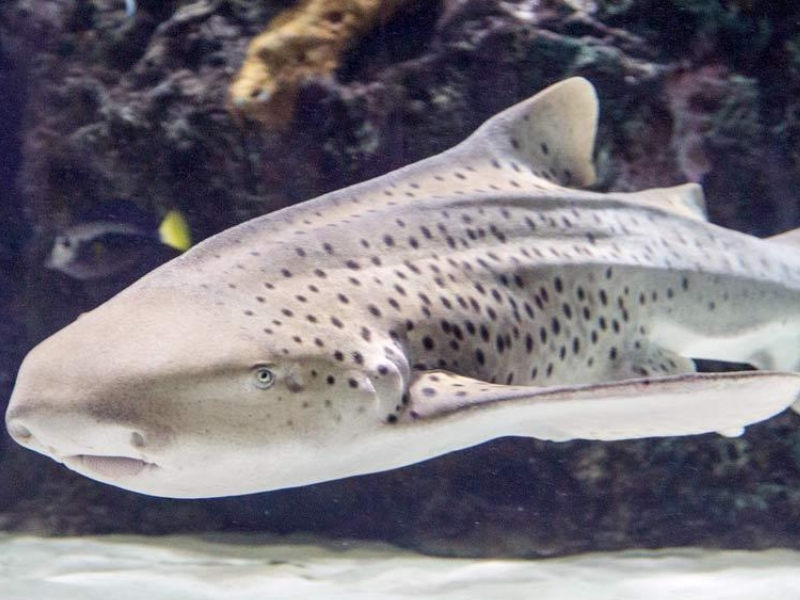
ZEBRA SHARK
Length: Up to 3.5 meters | Up to 11.5 feet
Weight: Up to 35 kg
Zebra Shark, also known as the Leopard Shark or Stegostoma fasciatum, is a large and distinctive species of carpet shark found in the Red Sea and other tropical waters around the world. They have a long and flattened body with a broad, rounded head and small eyes. Their skin is covered in black spots and stripes, giving them their distinctive zebra-like appearance. Zebra Sharks are typically found on sandy or rocky bottoms in shallow waters, where they hunt for crustaceans, mollusks, and small fish. They are generally docile and not considered a threat to humans, although they may become aggressive if provoked. Zebra Sharks are a popular species for aquariums due to their unique appearance and peaceful nature.
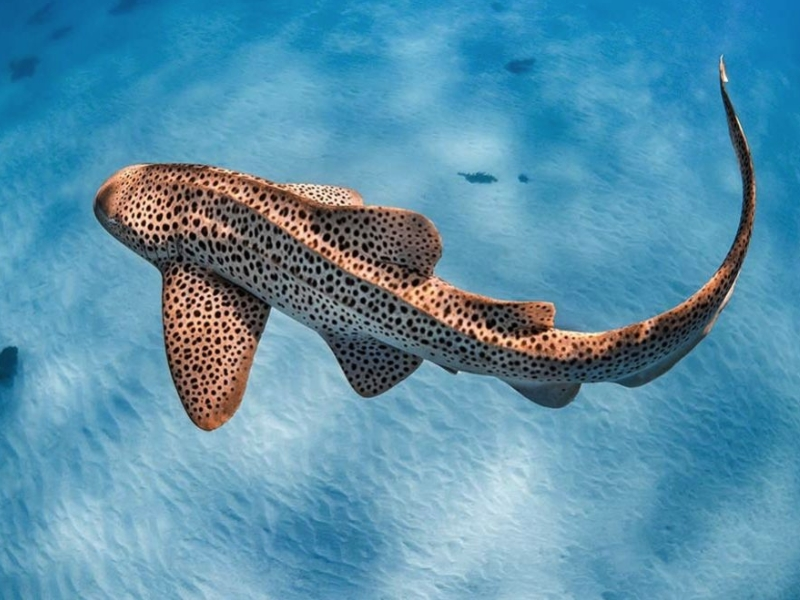
LEOPARD SHARK
Length: Up to 2.5 meters | Up to 8 feet
Weight: Up to 25 kg
Leopard Shark, also known as the Triakis semifasciata, is a species of hound shark that is found in the eastern Pacific Ocean, including the Red Sea. They have a slender body with a flattened head and a distinctive pattern of dark spots and saddle markings on their skin. Leopard Sharks are typically found in shallow waters, such as estuaries and bays, where they feed on a variety of prey including small fish, crustaceans, and cephalopods. They are not considered a danger to humans and are often encountered by divers in the Red Sea. Leopard Sharks are a popular species for aquariums due to their unique pattern and peaceful nature.
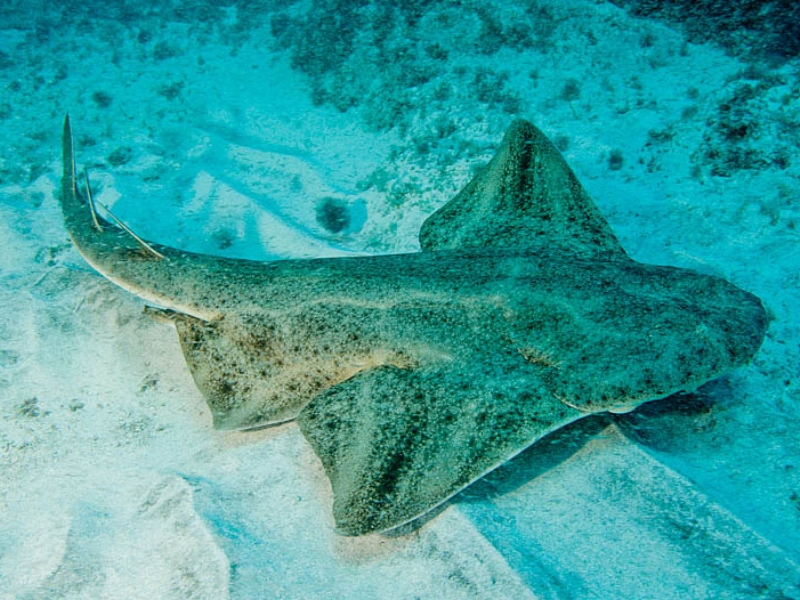
ANGEL SHARK
Length: Up to 2.4 meters | Up to 8 feet
Weight: Up to 80 kg
Angel Shark, also known as Squatina squatina, is a species of shark that is found in the Red Sea and other parts of the eastern Atlantic Ocean. They have a flattened body with broad pectoral fins that are used to “walk” along the ocean floor. Angel Sharks are typically gray or brown in color with a mottled pattern that allows them to blend in with the sandy or rocky bottoms where they live. They are ambush predators that feed on a variety of prey including fish, crustaceans, and cephalopods. Angel Sharks are not considered a threat to humans and are rarely encountered by divers due to their nocturnal habits and tendency to hide in the sand. They are a protected species due to overfishing and habitat loss.
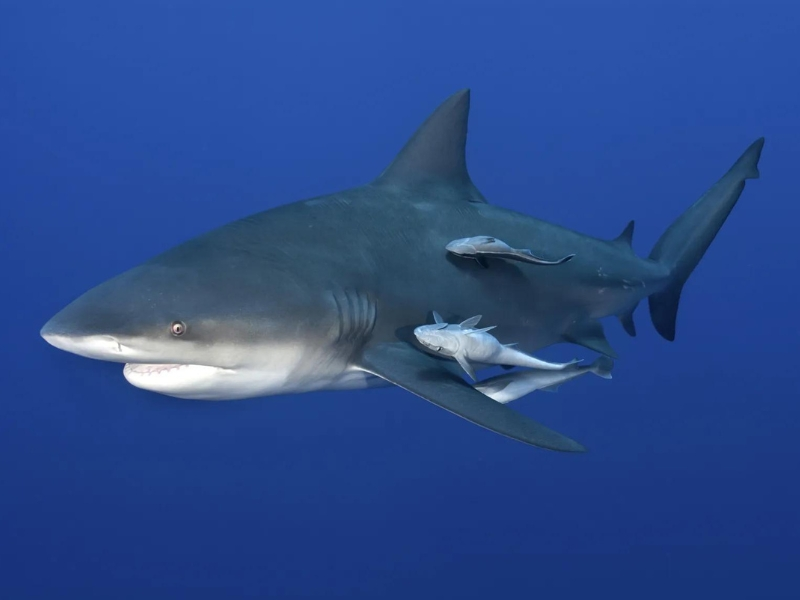
BULL SHARK
Length: Up to 3.5 meters | Up to 11.5 feet
Weight: Up to 315 kg
Bull Shark, also known as Carcharhinus leucas, is a species of shark that is found in warm, shallow waters around the world, including the Red Sea. They have a stout, muscular body with a short, blunt snout and small eyes. Bull Sharks are gray or brown in color with a white belly. They are known for their aggressive behavior and can be dangerous to humans, as they often swim in waters close to shore, including estuaries and river mouths. Bull Sharks are opportunistic feeders and will eat almost anything, including fish, dolphins, and even other sharks. They are considered one of the most dangerous sharks in the world due to their aggressive behavior and tendency to swim in areas frequented by humans. Divers should exercise caution when diving in areas where Bull Sharks are present.
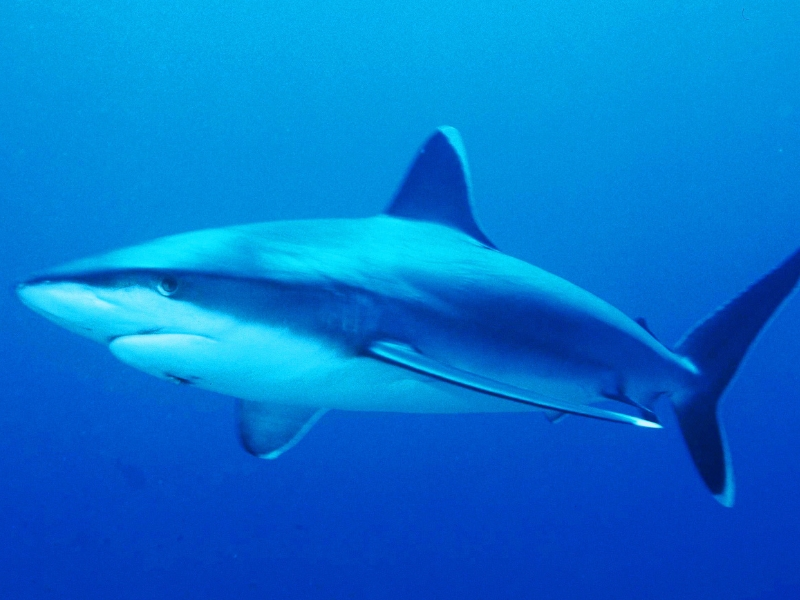
SILVERTIP SHARK
Length: Up to 3 meters | Up to 10 feet
Weight: Up to 160 kg
Silvertip Shark, also known as Carcharhinus albimarginatus, is a species of requiem shark found in the Red Sea and other warm waters around the world. They have a slender, streamlined body with a pointed snout and large eyes. Silvertip Sharks are gray or brown in color with a distinctive white tips on their dorsal and caudal fins, which gives them their name. They are typically found in deep waters, but can also be encountered in shallow reef areas. Silvertip Sharks are known to be curious and may approach divers, but are not considered a threat to humans unless provoked. They feed on a variety of prey including fish, squid, and octopus. Silvertip Sharks are considered an important species for commercial and recreational fishing, but are also protected in some areas to prevent overfishing.
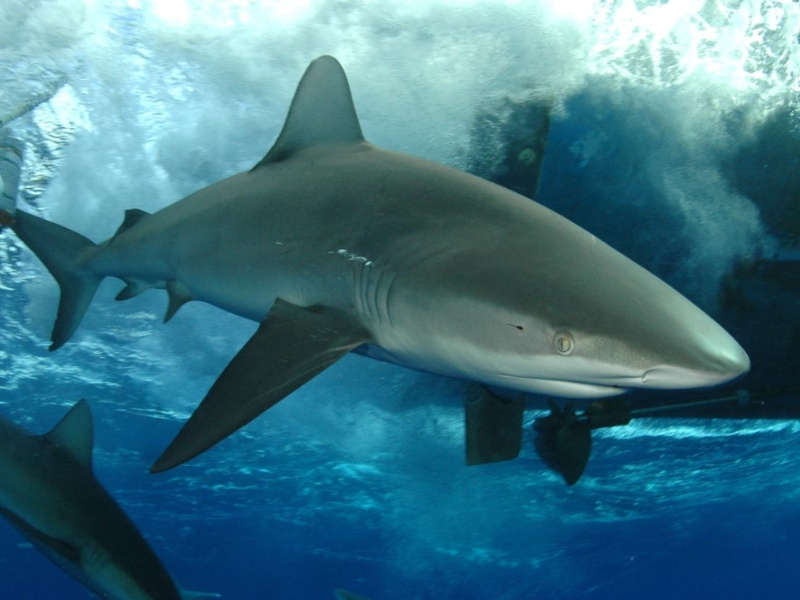
GALAPAGOS SHARK
Length: Up to 3.7 meters | Up to 12 feet
Weight: Up to 150 kg
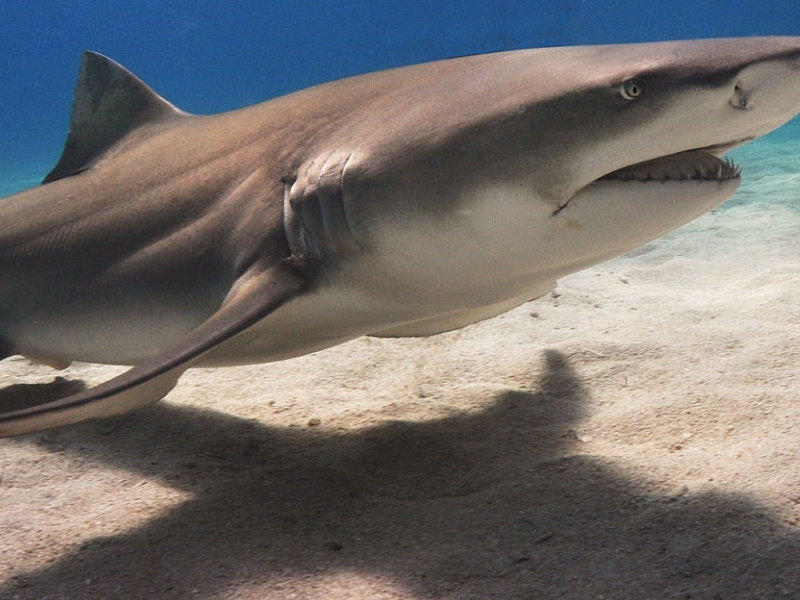
LEMON SHARK
Length: Up to 3.4 meters | Up to 11 feet
Weight: Up to 190 kg
Lemon Shark, also known as Negaprion brevirostris, is a species of shark found in the Red Sea and other tropical and subtropical waters around the world. They have a stout, streamlined body with a short, blunt snout and large, round eyes. Lemon Sharks are typically yellow or brown in color with a lighter belly. They are known for their non-aggressive behavior and are not considered a threat to humans, although they may become territorial if provoked. Lemon Sharks feed on a variety of prey including fish, crustaceans, and mollusks. They are considered an important species for commercial and recreational fishing, but are also protected in some areas to prevent overfishing. Lemon Sharks are also popular among divers due to their relatively calm and approachable nature.
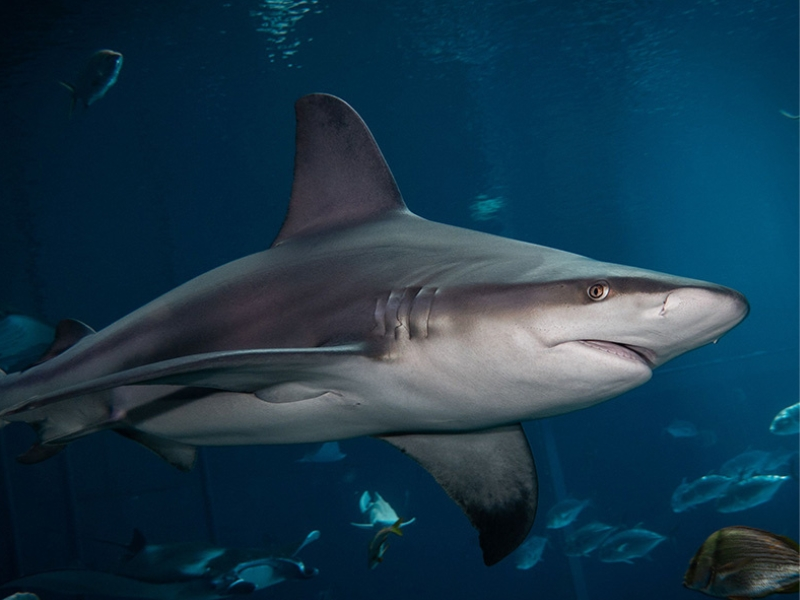
SANDBAR SHARK
Length: Up to 2.5 meters | Up to 8 feet
Weight: Up to 150 kg
Shark Diving in Egypt: Top Dive Sites to Spot Sharks
Egypt is known for its diverse marine life and stunning coral reefs, but it’s also a popular destination for shark diving. Here are some of the top dive sites in Egypt where you can spot different species of sharks:
Brothers Islands: The Brothers Islands are located in the middle of the Red Sea and are a popular spot for shark diving. Here, you can see schools of hammerhead sharks, oceanic whitetip sharks, and even the occasional sighting of a great white shark.
Daedalus Reef: Daedalus Reef is another popular dive site for shark enthusiasts. This site is famous for its resident population of scalloped hammerhead sharks, as well as oceanic whitetips and thresher sharks.
Elphinstone Reef: Elphinstone Reef is located near Marsa Alam and is a great place to spot reef sharks, including whitetips and blacktips. Occasionally, you may also see hammerhead sharks, tiger sharks, and even the occasional manta ray.
St. John’s: St. John’s is a collection of reefs and dive sites located in the southern Red Sea. Here, you can spot a variety of shark species, including hammerheads, grey reef sharks, silvertips, and oceanic whitetips.
These dive sites offer a unique and thrilling experience for shark enthusiasts. However, it’s important to always dive responsibly and with a qualified guide to ensure a safe and unforgettable dive.
